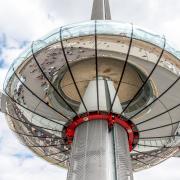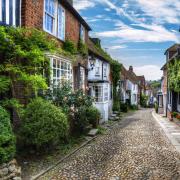This relatively modern town was, as its name suggests, a rural heathland in times gone by. But everything changed with the arrival of the London to Brighton railway in 1841. Haywards Heath has subsequently become the quintessential mid Sussex town.
OUSE VALLEY VIADUCT
Described as “Probably the most elegant viaduct in Britain” by the National Transport Trust, the Ouse Valley Viaduct is a pleasure to see and a pleasure to travel over. The viaduct is almost 100 feet tall, sitting on 37 semi-circular arches. Opened it 1841, it took two years to construct.

MUSTER GREEN MEMORIAL
The Grade II Listed war memorial at Muster Green was unveiled on November 30th 1924. It is described in its listing as 'an eloquent witness to the tragic impact of world events on this local community, and the sacrifice it has made in the conflicts of the 20th century.' Very well put.

BATTLE OF HAYWARDS HEATH
In memory of The Battle of Haywards Heath at nearby Muster Green, a painting in the Town Hall depicts the two sides who fought the English Civil War; the Royalists and the Parliamentarians, also known as the Cavaliers and the Roundheads respectively. The latter names were both slightly derogatory of course. ‘Cavaliers’ is the Spanish word for armed horsemen and they were considered to be wealthy men lacking morals. ‘Roundheads’ referenced many of their supporters being Puritans who wore their hair short.

MILLER AND CARTER
The Miller and Carter restaurant on Muster Green is one of the oldest buildings in town. Dating from the late 16th century, it was originally a bay timber-framed building before being re-fronted in the 19th century. It spent most of its life as The Sergison Arms public house, later becoming The Dolphin.

CÔTE BRASSERIE
There are certainly some eclectic architectural styles on display in town, like this steepled building around where The Broadway becomes Perrymount Road. The building had once been a garage before becoming the town’s first cinema, The Heath Theatre, which opened in 1911.

MUSTER COURT
Fairly close to the town centre are some blocks of flats called Muster Court and in the middle of them is this relic of the Victorian age of steam. It’s a vent used to draw fresh air into the tunnel below - one of the shortest tunnels on the London to Brighton line.

FORMER ST FRANCIS HOSPITAL
In 1859, this incredible Italianate structure opened as the Sussex County Lunatic Asylum, before becoming part of the then newly-created NHS, sensibly rebranding itself as The St Francis Hospital, in 1948. After a period of decline after the 1980s, it closed completely in 1995. It has subsequently been beautifully redeveloped into apartments as Southdown Park.

BLUE PLAQUE
A blue plaque put up in 2015 on The Broadway remembers Commando, a pigeon used by British Armed Forces during World War 2 to carry intelligence. The pigeon carried out more than 90 missions and was awarded the Dickin Medal, a Victoria Cross equivalent for animals. The bird was bred in Haywards Heath by Sid Moon, who had served in the First World War with the Army Pigeon Service.

LINDFIELD
Just a mile to the north of Haywards Heath is the beautiful village of Lindfield which can trace its history back more than 1200 years. All Saints Church alone, at the top of the High Street, dates back to just after the Norman invasion of 1066. The High Street is awash with medieval timber-framed houses and there is a beautiful natural spring-fed village pond.

ARDLINGLY RESERVOIR
Five miles to the north of town you can find Ardingly Reservoir, a nature reserve owned and operated by South East Water. It’s a popular local site for fishing as well as watersports like sailing, paddleboarding, rowing and windsurfing.

THE LOCAL VIEW - STEVE TRICE
Local resident Steve Trice says: ‘Haywards Heath is a vibrant town with a good shopping centre and lots of open spaces for recreation and leisure enjoyment. It has great links to Brighton, Crawley and London. We have lots of voluntary groups like the Church Activity, a food bank and the Woodside Community Centre. So there’s a really strong sense of community in Haywards Heath. I think it’s a happy place.’



























